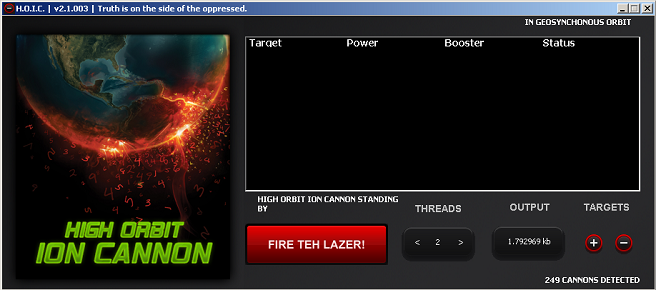

It was launched in retaliation for the shutting down of Megaupload, a filesharing website, and targeted websites belonging to the U.S. This differs from LOIC, which requires thousands of users to coordinate and launch an attack.Īnonymous first used HOIC in 2012 during Operation Megaupload - at the time one of the largest DDoS assaults ever recorded. Firepower – An individual HOIC user can launch a significant number of junk requests at a given time as few as 50 perpetrators can execute a successful DDoS attack.This differs from LOIC, which isn’t capable of obfuscating attacker IP addresses. Detection – HOIC uses booster scripts that let perpetrators scatter attack traffic and hide their geolocation.HOIC was designed to improve upon several LOIC application flaws, including: Used for denial of service (DoS) and distributed denial of service (DDoS) attacks, it functions by flooding target systems with junk HTTP GET and POST requests. Doing so helps them prevent fast-evolving DDoS attacks free.High Orbit Ion Cannon (HOIC) is a free, open-source network stress application developed by Anonymous, a hacktivist collective, to replace the Low Orbit Ion Cannon (LOIC).
#Loic vs hoic update#
Website owners also need to update the software on network devices and all servers, and use DDoS protection service. As a result, it is critical to understand all the recently released DDoS attack tools and adopt a DDoS mitigation service. Reducing DDoS Attack Tool’s ThreatsĮxtensive accessibility of DDoS Tools allows anybody with minimal technical knowledge to initiate a massive attack. A user can generate numerous concurrent connections to the server, exhausting its connection table to trigger a denial of service state. RUdy compels the target server to freeze while waiting for the remaining HTTP POST request. With a single byte, a RUDY attack can force application threads to wait for the end of continuous posts to execute processing. R U Dead Yet is a slow DDoS attack tool that denies service through the use of long-form field HTTP POST compliance instead of HTTP headers. If the server’s backend is vulnerable and utilizes SQL, it only needs a few machines to execute a massive outage. Unlike other DDoS tools, #Refref does not need numerous machines to break a server as a result if its attack vector.

#Loic vs hoic code#
Nonstop generation of a few code lines absorbs the purposed server’s resources and this results in denial of service for the server. This tool compels a target server into using a unique SQL function that generates SQL expressions repeatedly. #Refref relies on vulnerabilities in the SQL software database that facilitates injection attacks. When numerous connections are launched to the server in this way, handling legitimate requests becomes difficult. Through transmitting HTTP headers to the intended website in small chunks slowly the server, it compels the server to wait for the headers. Slowloris generates a DoS condition on a server by adopting a slow HTTP request. Many of the slow and more complex DDoS attacks depend on easy to use tools to execute hard to detect service denial strikes. Hping is a popular robust tool that many cyber criminals prefer.

Hping can also come from a certain user-defined source. Hping can send massive TCP traffic volumes to the target while imitating the IP address to make it appear random. It comes with more functionality than transmitting an ICMP echo request. The hping DDoS tool is a primary command-line utility that is comparable to the ping utility. This setup allowed more effective DDoS tools attacks. It then relocates control of the server to the main user who can then transmit commands over IRC to connected LOIC clients concurrently. LOIC would later get the Hivemind feature that allows users to direct a copy of LOIC at an IRC server. LOIC was originally developed to assist developers to direct heavy traffic towards their servers for testing.Īnonymous, a Hacktivist group would later use LOIC to initiate integrated DDoS attacks. LOIC is a clear flooding tool that can trigger massive volumes of HTTP, UDP, or TCP traffic to expose a server to heavy network load. This DDoS attack tool is usually used by cybercriminals to launch attacks in different parts of the globe. HOIC attacks are anonymous and hard to block. Booster scripts enable users to determine target URL lists and determine data when producing attack traffic.

The main application explains the code during a DDoS tool attack to launch. HOIC’s effectiveness comes from booster add-on scripts, text files that come with extra basic code. HOIC is a clear basic script cross-platform for transmitting HTTP GET and POST requests enclosed in user-friendly GUI. Department of Justice’s decision to pull down. HOIC became popular after it was used to reciprocate the U.S.


 0 kommentar(er)
0 kommentar(er)
